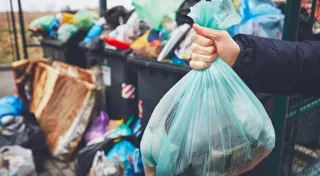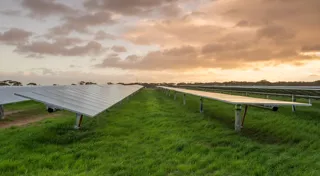CEFC drives $1 billion in smaller-scale clean energy projects as Bank of Queensland comes on board
13 August 2019
The CEFC has marked a major milestone in Australia’s clean energy transition, helping drive more than $1 billion in new investment in smaller-scale clean energy projects Australia-wide.
The milestone coincides with the launch of the CEFC’s latest co-financing program, a $100 million agreement with the Bank of Queensland’s BOQ Finance (BOQF) division, to help businesses switch to solar, energy storage and electric vehicles.*
In the past six years, the CEFC has worked with major banks and non-bank lenders to deliver tailored co-finance programs to businesses to encourage investment in clean energy technologies which can reduce their use of grid energy as well as lower their carbon emissions.
The CEFC finance has been used in more than 11,300 projects, ranging from $10,000 to $5 million. The average investment is $125,000. Businesses drawing on from these programs include manufacturers, agribusinesses and building owners.
CEFC CEO Ian Learmonth said: “We’re making a real difference for businesses across the country, by working with leading Australian lenders to provide competitive finance for clean energy investment. These co-finance programs have proved to be efficient, effective and easy to access for borrowers, who have used them to help finance more than $1 billion in new investments in clean energy.
“The co-finance programs allow us to rapidly extend the reach of our finance across a diverse range of projects, delivering real and measurable benefits to the economy and to our environment. We are delighted to now include Bank of Queensland Finance in this program.”
The CEFC’s co-finance programs have financed:
- More than 1,000 hybrids, battery electric vehicles and plug in hybrid electric vehicles.
- More than 4,400 rooftop solar projects, with a total investment value of more than $110 million.
- More than 400 projects for a variety of energy efficiency upgrades, including heating, ventilation and air conditioning projects, refrigeration upgrades, lighting improvements and a range of other qualifying energy efficiency technologies. The total investment value exceeds $260 million
- More than 1,000 projects for a range of on-farm and agribusiness projects, with a total investment value of more than $340 million.
BOQF is a leading player in the mid-market asset financing segment across Australia and New Zealand, delivering asset, cash flow and structured finance solutions to customers across a number of business lines.
BOQF Chief Executive Officer Verity Gilpin said: “We pride ourselves on our innovative approach to finance and delivering end-to-end solutions that transform the way our partners operate.
“An increasing number of our customers are seeking clean energy alternatives, and we are pleased to be working with CEFC to make the up-front investment in sustainable solutions simpler and more affordable.”
CEFC Transaction Lead Grace Tam added: “The BOQF Energy Efficient Equipment Finance program will help businesses capture the clean energy benefits of lower energy use, improved productivity and lower carbon emissions.
“It’s also great to see BOQF supporting customers to finance both their solar and battery storage solutions. This will become an increasingly important way for businesses to maximise the benefits of solar PV, while also avoiding peak charges for electricity by using more of the energy they generate on their own rooftops.”
The BOQF Energy Efficient Equipment Finance program is drawing on CEFC finance to offer a 0.7 per cent per annum discount on the finance rate for a range of eligible projects. Projects may include:
- Rooftop solar systems and solar thermal systems
- Agricultural equipment, including tractors, headers and irrigation
- Battery storage
- Battery electric vehicles and plug in hybrid electric vehicles
- Lighting, HVAC and commercial refrigeration equipment
For more information please see the BOQ Finance Energy Efficient Equipment Finance
FIVE FACTS ABOUT CLEAN ENERGY FINANCE AND TECHNOLOGIES
- Installing solar PV across the commercial, retail and industrial sectors in Australia pays back in under five years. (Source: Distributed energy in the property sector: Today’s opportunities p17)
- The payback period for LED lighting upgrades is less than five years across Australia. LEDs use less energy than fluorescents, halides and halogens. Less waste heat also means less pressure on air conditioning systems. The longer lifespan of LED lighting means less maintenance. (Source: Energy in Buildings: 50 Best Practice Initiatives p12)
- Energy efficient technologies can help manufacturers reduce their reliance on gas. Measures as simple as temperature control and efficient hot water nozzles can be implemented for a relatively low cost, with payback periods of 1 to 2 years. (Source: Australian Manufacturing Gas Efficiency Guide p16)
- The charging time and driving range of electric vehicles are expected to match those of internal combustion engines within five years. (Source: The Australian Electric Vehicle Market An Industry Snapshot from the Clean Energy Finance Corporation p7)
- Correctly ballasting a tractor using weights can help reduce fuel consumption, soil compaction and greenhouse gas emissions for under $5,000. (Source: CEFC research)
*BOQ closed the program in June 2022.
ABOUT THE BANK OF QUEENSLAND
BOQ is one of Australia’s leading regional banks and one of the few still not owned by Australia’s big banks. This means we offer a genuine alternative to anyone looking for a full range of personal and business banking services. We’ve been doing business since 1874 and pride ourselves on building long-term customer relationships that are based on mutual respect and understanding. Our relationship model is supported by simple, easy-to-understand banking products to help meet our customers’ financial needs. BOQ is one of the top 100 companies ranked by market capitalisation on the Australian Securities Exchange and are regulated by the Australian Prudential Regulation Authority as an Authorised Deposit-taking Institution.
Media release, 2019




